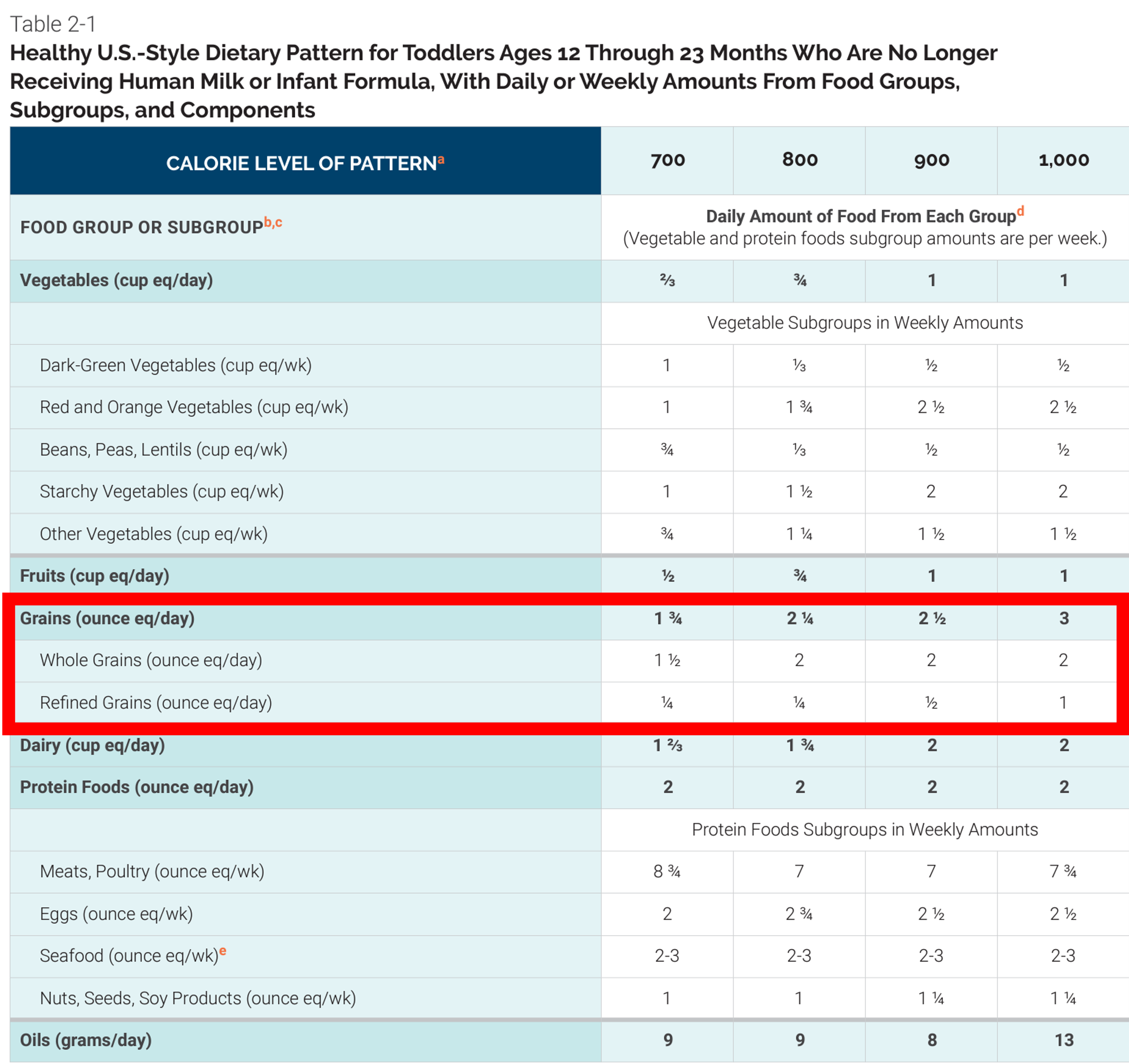Share This
Americans largely recognize that whole grains are an important part of a nutritious diet. However, taking a closer look at the 2020-2025 Dietary Guidelines for Americans reveals that making half our grains whole may not be enough for the youngest among us.
The 2020-2025 Dietary Guidelines for Americans were the first edition of the Guidelines that specifically addressed infant and toddler nutrition. Early childhood is a critical period of development, and feeding little ones often involves maximizing exposure to nutrition, tastes, and textures within their limited energy needs. The 2020-2025 Dietary Guidelines for Americans recommend that toddlers ages 12-23 months who are no longer receiving human milk or infant formula make anywhere from 67-89% of their grains whole — a detail that has largely gone unreported in nutrition communication.
In other words, the Dietary Guidelines for Americans don’t recommend that toddlers make half their grains whole – they recommend that toddlers make upwards of ⅔, and sometimes nearly all of their grains whole.*
Toddlers are in a period of rapid growth and development for which optimal nutrition is of the utmost importance. Yet at the same time, they have limited calorie needs and can only handle so much food in one day. This means that each bite has to deliver the biggest nutritional bang for your buck. Compared with refined or enriched wheat, whole wheat has roughly ten times the Vitamin E and vitamin B6, six times the amount of magnesium, four times the fiber, and more than 3 times the potassium, plus about 25% more protein.
Providing toddlers with enough whole grains can also help prevent one of the most common digestive issues in this age group: constipation. According to Malina Malkani, MS, RDN, CDN owner of Malina Malkani Nutrition and author of Safe and Simple Food Allergy Prevention, “constipation frequently becomes an issue during toddlerhood, which can worsen when inadequate dietary fiber intake coincides with potty training.” Malkani shares that parents can “help prevent constipation and its associated discomfort by exposing toddlers early and often to whole grains and helping them learn to like the flavor, taste, and texture of fiber-rich foods.”
Making it easier for families with toddlers to access whole grains is one way to help support whole grain consumption in youngsters. The U.S. Department of Agriculture’s Special Supplemental Nutrition Program for Women, Infants, and Children, commonly known as WIC, is a program that helps pregnant and breastfeeding women and children up to age 5 access nutrient-dense foods like fruits, vegetables, milk, eggs, and in recent years, whole grains.
An analysis of supermarket scanner data from 2,137 WIC households both before and after the 2009 WIC updates that included whole grains found that, “as a result of the WIC revisions, the share of 100% whole-grain bread in total bread purchases tripled (from 8% to 24%), replacing purchases of white bread; the share of brown rice rose to 30% of rice purchases.” Programs like these, which support whole grain accessibility for families, are critical as we work to increase whole grain consumption in young children.
Purchasing whole grains from the store is one thing, and getting them onto a young child’s plate and into their mouth is quite another. “When introducing whole grains to toddlers, we can increase acceptance by making foods fun, appealing, developmentally appropriate, and easy to chew,” explains Malkani.
For breakfast, Malkani suggests “hot whole-grain cereal (including amaranth, oatmeal, or millet) with mashed bananas, frozen whole-grain waffles topped with nut or seed butter and smashed berries, and whole-grain breads, English muffins, or bagels topped with butter, cream cheese, avocado, or another appealing spread.” For lunches and dinners, Malkani recommends “whole wheat pasta with tomato sauce, whole grain crackers served with a dip, brown rice topped with colorful veggies and a tasty sauce, or soups and stews made with whole grains like barley, farro, and freekeh.”
If you’re already making half of your toddler’s grains whole, the 2020-2025 Dietary Guidelines for Americans urge that there’s no reason to stop there. By incorporating more whole grains into daily meals, the whole family stands to benefit from the boost of flavors, textures, and nutrients that whole grains provide. (Kelly)
*Table 2-1, pictured top right, is from page 64 of the 2020-2025 Dietary Guidelines for Americans.
To have our Oldways Whole Grains Council blog posts (and more whole grain bonus content!) delivered to your inbox, sign up for our monthly email newsletter, called Just Ask for Whole Grains.



Add a Comment